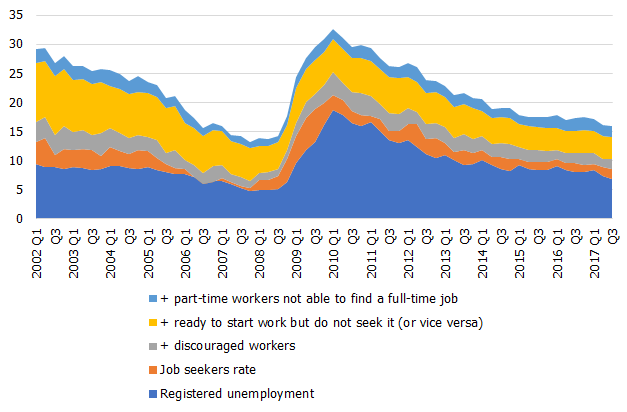2018: opportunity to make economic growth inclusive
For Latvijas Banka Monthly Newsletter, In Focus, December, 2017

This is partly inspired by the renewed EU fund inflows. Yet investment growth potential is far from exhausted given high levels of capital utilisation but still modest investment-to-GDP ratio.
The labour market tightened further with unemployment dipping below the natural rate. A survey shows that many entrepreneurs are planning to increase the number of employees in the coming months, and the number of vacancies is on a rise. Despite shrinking working age population and already historically high employment rates, labour reserves are not exhausted yet. There are persistent employment rate disparities across regions, education levels, age and ethnic groups with some municipalities still posting unemployment rates in excess of 20%. Therefore, strong labour demand should be regarded as an opportunity to make economic growth inclusive. First, it should return long-term unemployed and inactive discouraged workers to productive activities.
Second, strong labour demand is a precondition for those thousands of necessity-driven emigrants that left Latvia in the wake of economic crisis to think over coming back.
Securing stable jobs with high income and good prospects seems to be the most efficient "plan" to promote return migration.
Latvia is gradually losing the competitive advantage of low wages. The labour income share, after climbing up during the past few years, has currently stabilised close to the EU average level. This is bad news for firms operating in labour-intensive low-value-added sectors and/or in the shadow economy. Instead of investing and modernising production processes, some of these firms might support immigration. However, low-skilled immigration would only slow income convergence and impede growth inclusiveness. A country able to compete only with low wages will never achieve high living standards, and is likely to stuck in the so- called middle income trap.
It seems that 2018 is going to be another year of cyclical expansion, and the economy might slightly exceed its full potential. Strong demand for labour and a substantial minimum wage increase by 13% are likely to push the average monthly wage beyond the 1 000 euro threshold. How sustainable will this economic upswing be? It depends on whether labour productivity will keep pace with the wage growth. Labour productivity stemming from capital accumulation, technology and efficiency could be enhanced, inter alia, by raising quality of education, healthcare and institutions. The necessity of structural reforms in these areas has been highlighted by Latvijas Banka for years.
Alternative unemployment definitions (% of economically active population)

Textual error
«… …»


